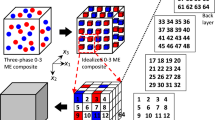Abstract
A micromechanical model based on the bridging theory is proposed for predicting the effective coefficients of two-phase magnetoelectric composites. The 17 different coefficients, including the effective elastic, piezoelectric, piezomagnetic, dielectric, magnetic permeability and magnetoelectric coupling coefficients, are divided into two groups based on the analysis of existing results of the classical micromechanical models. The relationship between the strain field, electric field and the magnetic field of two constituents is presented. The results are well matched with the finite element results. The classical models for predicting the effective coefficients of magnetoelectric composites can be covered flexibly by the presented unified micromechanical model.









Similar content being viewed by others
References
Nan, C.W., Bichurin, M.I., Dong, S., Viehland, D., Srinivasan, G.: Multiferroic magnetoelectric composites: historical perspective, status, and future directions. J. Appl. Phys. 103(3), 31101 (2008)
Nan, C.W.: Magnetoelectric effect in composites of piezoelectric and piezomagnetic phases. Phys. Rev. B 50(9), 6082–6088 (1994)
Benveniste, Y.: Magnetoelectric effect in fibrous composites with piezoelectric and piezomagnetic phases. Phys. Rev. B 51(22), 16424–16427 (1995)
Benveniste, Y.: On the micromechanics of fibrous piezoelectric composites. Mech. Mater. 18(3), 183–193 (1994)
Benveniste, Y.: Exact results in the micromechanics of fibrous piezoelectric composites exhibiting pyroelectricity. Proc. Math. Phys. Sci. 441(1911), 59–81 (1993)
Hashin, Z.: Analysis of properties of fiber composites with anisotropic constituents. J. Appl. Mech. 46(3), 543 (1979)
Milgrom, M., Shtrikman, S.: Linear response of two-phase composites with cross moduli: exact universal relations. Phys. Rev. A Gen. Phys. 40(3), 1568–1575 (1989)
Li, J.Y., Dunn, M.L.: Micromechanics of magnetoelectroelastic composite materials: average fields and effective behavior. J. Intell. Mater. Syst. Struct. 9(6), 404–416 (1998)
Eshelby, J.D.: The determination of the elastic field of an ellipsoidal inclusion, and related problems. Math. Phys. Sci. 241(1226), 376–396 (1957)
Mori, T., Tanaka, K.: Average stress in matrix and average elastic energy of materials with misfitting inclusions. Acta Metall. 21(5), 571–574 (1973)
Chen, T.: Exact moduli and bounds of two-phase composites with coupled multifield linear responses. J. Mech. Phys. Solids 45(3), 385–398 (1997)
Liu, J., Liu, X., Zhao, Y.: Green’s functions for anisotropic magnetoelectroelastic solids with an elliptical cavity or a crack. Int. J. Eng. Sci. 39(12), 1405–1418 (2001)
Huang, G.Y., Wang, B.L., Mai, Y.W.: Effective properties of magnetoelectroelastic materials with aligned ellipsoidal voids. Mech. Res. Commun. 36(5), 563–572 (2009)
Aboudi, J.: Micromechanical analysis of fully coupled electro-magneto-thermo-elastic multiphase composites. Smart Mater. Struct. 10(5), 867–877 (2001)
Lee, J., Boyd, J.G., Lagoudas, D.C.: Effective properties of three-phase electro-magneto-elastic composites. Int. J. Eng. Sci. 43(10), 790–825 (2005)
Wang, Y., Weng, G.J.: Magnetoelectric coupling and overall properties of multiferroic composites with 0–0 and 1–1 connectivity. J. Appl. Phys. 118(17), 174102 (2015)
Huang, Z.M.: A unified micromechanical model for the mechanical properties of two constituent composite materials. part I: elastic behavior. J. Thermoplast. Compos. Mater. 13(4), 252–271 (2000)
Huang, Z.M.: A unified micromechanical model for the mechanical properties of two-constituent composite materials. part II:plastic behavior. J. Thermoplast. Compos. Mater. 13(5), 344–362 (2000)
Pakam, N., Arockiarajan, A.: An analytical model for predicting the effective properties of magneto-electro-elastic (MEE) composites. Comput. Mater. Sci. 65, 19–28 (2012)
Huang, Z.M.: Micromechanical failure analysis of unidirectional composites. InTech Open Access publisher, pp. 1–42 (2018).
Lee, J., Iv, J.G.B., Lagoudas, D.C.: Effective properties of three-phase electro-magneto-elastic composites. Int. J. Eng. Sci. 43(10), 790–825 (2005)
Xu, R.C., Wang, Z.H., Chen, G., Li, C.Y., Gao, R.L.: Research progress on magnetoelectric coupling effect of multiferroic composites. China Ceram. 54(9), 1–11 (2018). ((in Chinese))
Avakian, A., Ricoeur, A.: Constitutive modeling of nonlinear reversible and irreversible ferromagnetic behaviors and application to multiferroic composites. J. Intell. Mater. Syst. Struct. 27(18), 2536–2554 (2016)
Jiang, M.H., Xu, P., Cheng, G.: Static elastic modulus and compressive strength of giant magnetostrictive composites. Rare Met. Mater. Eng. 34(6), 912–915 (2005). ((in Chinese))
Acknowledgements
This work was supported by the National Natural Science Foundation of China (11832014, 11972257 and 11472193), the China Scholarship Council (CSC) and the Fundamental Research Funds for the Central Universities (2212018022).
Author information
Authors and Affiliations
Corresponding author
Additional information
Publisher's Note
Springer Nature remains neutral with regard to jurisdictional claims in published maps and institutional affiliations.
Appendices
Appendix A
The expressions B1 appearing in Eq. (79) and B2 appearing in Eqs. (70), (73) and (76) take the following form:
The expressions, \(C_{2}\) and \(C_{3}\) appearing in Eqs. (70), (73), (76), (77), (79) and (81) take the following form:
The expressions \(D_{1}\), \(D_{7}\) appearing in Eq. (70), \(D_{{2}}\) and \(D_{{3}}\) appearing in Eq. (76), \(D_{{4}}\) and \(D_{{5}}\) appearing in Eq. (77) and \(D_{{6}}\) appearing in Eq. (79) take the following form:
The expressions \(E_{1}\) appearing in Eq. (35), \(E_{2}\) appearing in Eq. (A.8) and (105), \(E_{3}\) appearing in Eqs. (73), (77), (99), (100) and (102), \(E_{4}\) appearing in Eqs. (77), (81) and (104) and \(E_{{5}}\) appearing in Eqs. (66) and (67) take the following form:
Appendix B
In order to help readers to be clearer about the expression of the bridging element, we again give the nonzero elements of the bridging element in Appendix B for readers to browse. The non-elements of the bridging matrix are given by the order in which they appear in the article.
Equation (108) appearing in Eq. (34), and Eqs. (109), (110), (111) appearing in Eqs. (39) take the following form:
where equations related to A11 and A21 are:
Equation (113)–(118) appearing in Eqs. (45)–(50) take the following form:
where equations related to A, \(A_{1010}^{1} ,A_{75}^{1} ,A_{710}^{1} ,A_{48}^{1} ,A_{105}^{1}\) and \(A_{107}^{1}\) are:
Equation (126)–(127) appearing in Eqs. (62)–(63) takes the following form:
where the parameters \(\beta\) and \(\gamma\) are given as follows:
Rights and permissions
About this article
Cite this article
Yang, J., Zhou, Y. A micromechanical model for the effective properties of two-phase magnetoelectric composites. Arch Appl Mech 92, 2549–2568 (2022). https://doi.org/10.1007/s00419-022-02195-1
Received:
Accepted:
Published:
Issue Date:
DOI: https://doi.org/10.1007/s00419-022-02195-1




